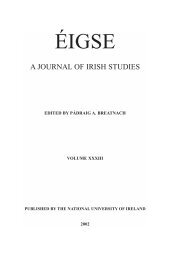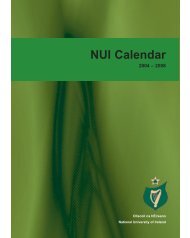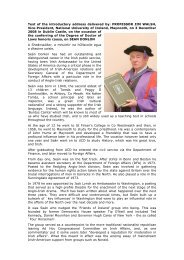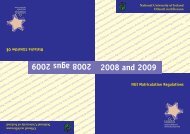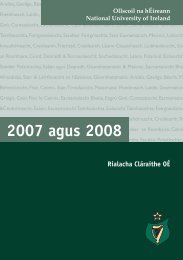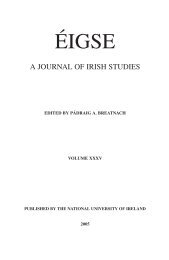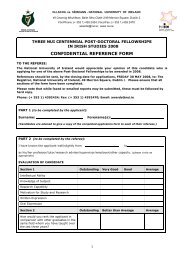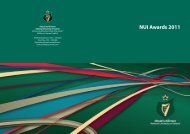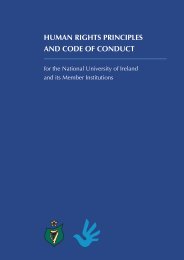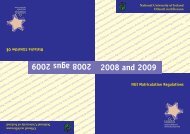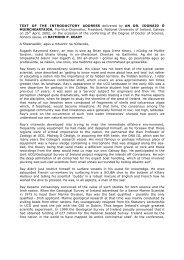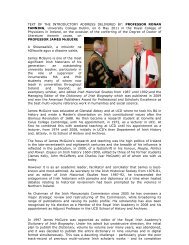Eigse Paged 2004 - National University of Ireland
Eigse Paged 2004 - National University of Ireland
Eigse Paged 2004 - National University of Ireland
Create successful ePaper yourself
Turn your PDF publications into a flip-book with our unique Google optimized e-Paper software.
ENCOUNTER AT THE FORD 15<br />
and the Celts appear generally to have conceived <strong>of</strong> rivers as goddesses.<br />
14<br />
Yet another significant element in the Cesair story, rendered<br />
explicit in some <strong>of</strong> its versions, is that <strong>of</strong> the threat posed by the<br />
women’s sexuality. Ladru, the first <strong>of</strong> the men to die, is said to have<br />
succumbed to robanach ‘excessive womanising’, 15 and the second<br />
recension <strong>of</strong> Lebor Gabála says that when Fintan retired to his cave<br />
he ‘escaped, fleeing before all the women.’ 16 The most vivid evocation<br />
<strong>of</strong> this dimension <strong>of</strong> the tale is to be found in two pages, written<br />
in an unknown hand, preserved among the manuscript notes <strong>of</strong> the<br />
Elizabethan scholar Meredith Hanmer. It must remain a matter <strong>of</strong><br />
speculation whether the writer had access to an older source<br />
unknown to us, or whether his own imagination was stimulated by<br />
the general outlines <strong>of</strong> the story. Like Lebor Gabála, he says that<br />
Ladru was dissatisfied because he received one consort fewer than<br />
the other two men when the women were divided. For what follows,<br />
however, no close precedent can be cited.<br />
The two others being wiser graunted him leaue to doe his will<br />
with their owne parte <strong>of</strong> the women as <strong>of</strong>ten as he would, and<br />
by meanes <strong>of</strong> that he dyed shortely after wardes and soone after<br />
that, the second dyed, so that at last FIONNTAIN that survived<br />
being affrayed to dye as his felowes thought with him self to<br />
eschew the sight <strong>of</strong> all the women except the chiefest onely, &<br />
calling hir aside told the secret <strong>of</strong> winde vnto hyr, which was<br />
that she should flye away prively with him self & leaue the<br />
company <strong>of</strong> the rest <strong>of</strong> the women for that if it were he should<br />
be able to provide other necessarie thinges for them, it was<br />
impossible for him to satisfie the lust <strong>of</strong> their bodyes, & consequently<br />
desireth hir to keepe secretly this counsell from all the<br />
women.<br />
14<br />
Thus Joseph Vendryes, La religion des Celtes ( 1 1948; 2 Spézet 1997) 49-50;<br />
Bernhard Maier, Die Religion der Kelten: Götter – Mythen – Weltbild (Munich,<br />
2001) 81. The Rhine (< *Rēnos; cf. Irish rian ‘sea, Rhine’) is the most conspicuous<br />
example <strong>of</strong> a river to which Celts gave a masculine name.<br />
15<br />
This statement is already found in a poem by Gilla Coemáin (fl. 1072): text in LG<br />
V 486 l. 3856. See the explanation <strong>of</strong> Ladru’s death, as coming do fhuráil banaich<br />
‘from too much womanising’, in the second and third recensions ibid. II 188, 204; or<br />
do dul chuca ‘from going to them’ in the poem Cethracha tráth don tur tind (ibid.<br />
222 l. 817).<br />
16<br />
LG II 192: Élaid iarom Fintan for teched riana mnaíb uile. Cf. ibid. 206.



